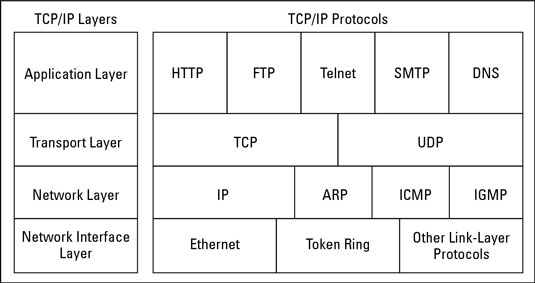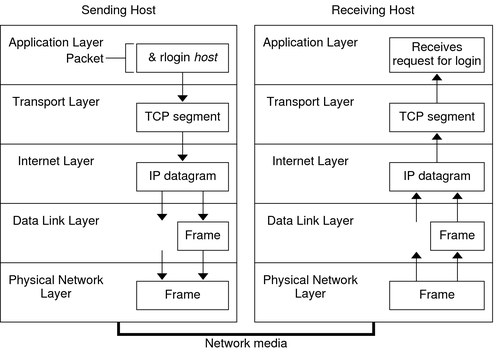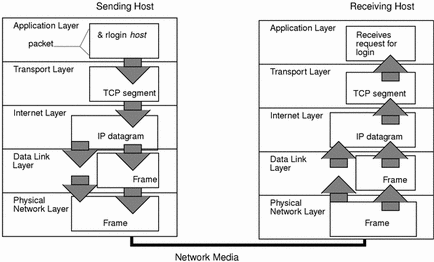
Ipv6 And Ipv4 Differences

IPv4 vs IPv6: What’s the Difference Between IPv4 and IPv6?
What is IP?
An IP (Internet Protocol) address is a numerical label assigned to each device connected to a computer network that uses the IP protocol for communication. An IP address acts as an identifier for a specific device on a particular network. The IP address is also called an IP number or Internet address.
IP address specifies the technical format of the addressing and packets scheme. Most networks combine IP with a TCP (Transmission Control Protocol). It also allows developing a virtual connection between a destination and a source.
Now in this IPv4 and IPv6 difference tutorial, we will learn What is IPv4 and IPv6?
What is IPv4?
IPv4 is an IP version widely used to identify devices on a network using an addressing system. It was the first version of IP deployed for production in the ARPANET in 1983. It uses a 32-bit address scheme to store 2^32 addresses which is more than 4 billion addresses. It is considered the primary Internet Protocol and carries 94% of Internet traffic.
What is IPv6?
IPv6 is the most recent version of the Internet Protocol. This new IP address version is being deployed to fulfill the need for more Internet addresses. It was aimed to resolve issues that are associated with IPv4. With 128-bit address space, it allows 340 undecillion unique address space. IPv6 is also called IPng (Internet Protocol next generation).
Internet Engineer Taskforce initiated it in early 1994. The design and development of that suite are now called IPv6.
KEY DIFFERENCE
IPv4 is 32-Bit IP address whereas IPv6 is a 128-Bit IP address.
IPv4 is a numeric addressing method whereas IPv6 is an alphanumeric addressing method.
IPv4 binary bits are separated by a dot(. ) whereas IPv6 binary bits are separated by a colon(:).
IPv4 offers 12 header fields whereas IPv6 offers 8 header fields.
IPv4 supports broadcast whereas IPv6 doesn’t support broadcast.
IPv4 has checksum fields while IPv6 doesn’t have checksum fields
When we compare IPv4 and IPv6, IPv4 supports VLSM (Variable Length Subnet Mask) whereas IPv6 doesn’t support VLSM.
IPv4 uses ARP (Address Resolution Protocol) to map to MAC address whereas IPv6 uses NDP (Neighbour Discovery Protocol) to map to MAC address.
Features of IPv4
Following are the features of IPv4:
Connectionless Protocol
Allow creating a simple virtual communication layer over diversified devices
It requires less memory, and ease of remembering addresses
Already supported protocol by millions of devices
Offers video libraries and conferences
Features of IPv6
Here are the features of IPv6:
Hierarchical addressing and routing infrastructure
Stateful and Stateless configuration
Support for quality of service (QoS)
An ideal protocol for neighboring node interaction
IPv4 vs IPv6
Difference Between IPv4 and IPv6 Addresses
IPv4 & IPv6 are both IP addresses that are binary numbers. Comparing IPv6 vs IPv4, IPv4 is 32 bit binary number while IPv6 is 128 bit binary number address. IPv4 address are separated by periods while IPv6 address are separated by colons.
Both are used to identify machines connected to a network. In principle, they are the same, but they are different in how they work. Below are the main differences between IPv4 and IPv6:
Basis for differences
IPv4
IPv6
Size of IP address
IPv4 is a 32-Bit IP Address.
IPv6 is 128 Bit IP Address.
Addressing method
IPv4 is a numeric address, and its binary bits are separated by a dot (. )
IPv6 is an alphanumeric address whose binary bits are separated by a colon (:). It also contains hexadecimal.
Number of header fields
12
8
Length of header filed
20
40
Checksum
Has checksum fields
Does not have checksum fields
Example
12. 244. 233. 165
2001:0db8:0000:0000:0000:ff00:0042:7879
Type of Addresses
Unicast, broadcast, and multicast.
Unicast, multicast, and anycast.
Number of classes
IPv4 offers five different classes of IP Address. Class A to E.
lPv6 allows storing an unlimited number of IP Address.
Configuration
You have to configure a newly installed system before it can communicate with other systems.
In IPv6, the configuration is optional, depending upon on functions needed.
VLSM support
IPv4 support VLSM (Variable Length Subnet mask).
IPv6 does not offer support for VLSM.
Fragmentation
Fragmentation is done by sending and forwarding routes.
Fragmentation is done by the sender.
Routing Information Protocol (RIP)
RIP is a routing protocol supported by the routed daemon.
RIP does not support IPv6. It uses static routes.
Network Configuration
Networks need to be configured either manually or with DHCP. IPv4 had several overlays to handle Internet growth, which require more maintenance efforts.
IPv6 support autoconfiguration capabilities.
Best feature
Widespread use of NAT (Network address translation) devices which allows single NAT address can mask thousands of
non-routable addresses, making end-to-end
integrity achievable.
It allows direct addressing because of vast address
Space.
Address Mask
Use for the designated network from host portion.
Not used.
SNMP
SNMP is a protocol used for system management.
SNMP does not support IPv6.
Mobility & Interoperability
Relatively constrained network topologies to which move restrict mobility and interoperability capabilities.
IPv6 provides interoperability and mobility
capabilities which are embedded in network devices.
Security
Security is dependent on applications – IPv4 was not designed with security in mind.
IPSec(Internet Protocol Security) is built into the IPv6 protocol, usable with
a proper key infrastructure.
Packet size
Packet size 576 bytes required, fragmentation optional
1208 bytes required without fragmentation
Packet fragmentation
Allows from routers and sending host
Sending hosts only
Packet header
Does not identify packet flow for QoS handling which includes checksum options.
Packet head contains Flow Label field that specifies packet flow for QoS handling
DNS records
Address (A) records, maps hostnames
Address (AAAA) records, maps hostnames
Address configuration
Manual or via DHCP
Stateless address autoconfiguration using Internet Control Message Protocol version 6 (ICMPv6) or DHCPv6
IP to MAC resolution
Broadcast ARP
Multicast Neighbour Solicitation
Local subnet Group management
Internet Group Management Protocol GMP)
Multicast Listener Discovery (MLD)
Optional Fields
Has Optional Fields
Does not have optional fields. But Extension headers are available.
IPSec
Internet Protocol Security (IPSec) concerning network security is optional
Internet Protocol Security (IPSec) Concerning network security is mandatory
Dynamic host configuration Server
Clients have approach DHCS (Dynamic Host Configuration server) whenever they want to connect to a network.
A Client does not have to approach any such server as they are given permanent addresses.
Mapping
Uses ARP(Address Resolution Protocol) to map to MAC address
Uses NDP(Neighbour Discovery Protocol) to map to MAC address
Combability with mobile devices
IPv4 address uses the dot-decimal notation. That’s why it is not suitable for mobile networks.
IPv6 address is represented in hexadecimal, colon- separated notation.
IPv6 is better suited to mobile
networks.
IPv4 and IPv6 cannot communicate with other but can exist together on the same network. This is known as Dual Stack.

Everything You Need to Know About IPv4 vs. IPv6
The “IP” in IPv4 and IPv6 stands for Internet Protocol, which is a set of rules that determine how devices transmit data packets across the Internet. Internet Protocol also assigns a unique address to each device on the web. These addresses ensure data packets are routed to the correct device.
What is IPv4?
IPv4 or Internet Protocol Version 4 is the most common protocol for transmitting data packets on the web. IPv4 provides both the identification (IP addresses) for each device on the Internet and the rules that govern how data packets are transmitted between those devices.
With IPv4, a typical IP address has 32 bits and is in dotted-decimal form, like this:
192. 0. 2. 235
Because there are only 232 unique hosts in this decimal format, there are only about 4. 3 billion IPv4 addresses.
What is IPv6?
There’s been a massive increase in devices connected to the Internet in the last decade—with a rise from 5 Internet devices per household to 50 Internet devices per household from 2015 to 2020. This prompted the Internet Engineering Tracking Taskforce (IETF) to create a new Internet protocol, IPv6. It was released in December 1998.
IPv6 addresses are written in hexadecimal format, like this:
2001:0db8:85a3:0000:0000:8a2e:0370:7334
The Pros of IPv4 vs. IPv6
Despite IPv6 being the newer, updated IP, there are still many advantages of IPv4.
Existing infrastructure – Most websites use IPv4, even those that also support IPv6. This makes version four a more seamless experience. That is, until most of the Internet switches to version six.
Simplicity – IPv4’s 32-bit dotted decimal is much smaller and simpler than IPv6’s hexadecimal numbers. This simplicity is easier for humans to read.
Support – Because most traffic is still using IPv4, Network operators find IPv4 familiar. They may wait until more traffic is IPv6 before they make any decisions about their own infrastructure—especially if they have enough IPv4 addresses for the near future.
The Cons of IPv4 vs. IPv6
Running short on IPv4 addresses isn’t the only con of version four.
Exhaustion of IPv4 – As we’ve covered, the world is short on IPv4 addresses. This means there’s a cost to buy IPv4 addresses, where IPv6 addresses can be had (in unimaginable quantities) for the cost of registration with a regional registry (RIR). You also pay registry costs with IPv4.
IPv6 Speed – Web and cloud services provider, Akamai, measured the speed of IPv6 vs. IPv4. They found, “Sites load 5% faster in median and 15% faster for the 95% percentile on IPv6 compared to IPv4. ”
Network Address Translation (NAT) for IPv4 – NAT allows a group of devices (usually 10-20) that share a single public IP with IPv4. This requires complex configurations like forwarding and firewall alterations. Because IPv6 has so many addresses, IPv6 devices don’t require additional configuration.
Understanding the IPv4 market
The pros of IPv4, combined with the lack of addresses, created a new marketplace. Today, companies that need IPv4 addresses can buy them through IPv4 Brokers, or a company looking to move to IPv6 can sell IPv4 addresses.
When a company needs more IP addresses, they have three options:
Buy IPv4 addresses – That’s what is here for. Companies can also sell their IPv4 addresses if they’re beginning to deploy IPv6.
Use NAT – As mentioned above, NAT allows one address to be shared among many devices. However, NAT still requires one IPv4 address (usually one per 10-20 people). This has some drawbacks, namely speed issues as packets have to transition paths.
Deploy IPv6 – A business can deploy IPv6, but this may be of limited usefulness until most traffic is also on IPv6. So, even if a business deploys IPv6, it still needs more IPv4 addresses or NAT.
In Conclusion
There’s much debate around which is better—IPv4 or IPv6. But really, it’s about your specific needs. If you’d like more information on the differences between IPv4 vs. IPv6, or if you’re looking for help with either, please reach out to us today.

Differences between IPv4 and IPv6 – Linksys Official Support
The Internet Protocol version 4 (IPv4) is a protocol for use on packet-switched Link Layer networks (e. g. Ethernet). IPv4 provides an addressing capability of approximately 4. 3 billion addresses.
The Internet Protocol version 6 (IPv6) is more advanced and has better features compared to IPv4. It has the capability to provide an infinite number of addresses. It is replacing IPv4 to accommodate the growing number of networks worldwide and help solve the IP address exhaustion problem.
One of the differences between IPv4 and IPv6 is the appearance of the IP addresses. IPv4 uses four 1 byte decimal numbers, separated by a dot (i. e. 192. 168. 1. 1), while IPv6 uses hexadecimal numbers that are separated by colons (i. fe80::d4a8:6435:d2d8:d9f3b11).
Below is the summary of the differences between the IPv4 and IPv6:
IPv4IPv6No. of bits on IP Address32128FormatdecimalhexadecimalCapable of Addresses4. 3 billioninfinite numberHow to ping ping
Advantages of IPv6 over IPv4:
IPv6 simplified the router’s task compared to IPv4. IPv6 is more compatible to mobile networks than IPv4. IPv6 allows for bigger payloads than what is allowed in IPv4. IPv6 is used by less than 1% of the networks, while IPv4 is still in use by the remaining 99%.
Related Articles:
Checking the computer’s IPv6 AddressHow to verify if your system is capable of IPv6 connectivityLinksys devices that support IPv6
Frequently Asked Questions about ipv6 and ipv4 differences
Which is faster IPv4 or IPv6?
IPv6 Speed – Web and cloud services provider, Akamai, measured the speed of IPv6 vs. IPv4. They found, “Sites load 5% faster in median and 15% faster for the 95% percentile on IPv6 compared to IPv4.”Aug 18, 2020
Is IPv6 better than IPv4?
The Internet Protocol version 6 (IPv6) is more advanced and has better features compared to IPv4. It has the capability to provide an infinite number of addresses. It is replacing IPv4 to accommodate the growing number of networks worldwide and help solve the IP address exhaustion problem.

